Borchalo Carpets in Georgia: Kept Alive by Only 12 Weavers
Borchalo rug, renowned for its intricate designs and vibrant colors, is evidence of the rich cultural heritage of the Azerbaijani community living in Georgia. This almost extinct tradition, celebrated globally for its artistry and cultural significance, is slowly making a comeback. Thus, I dive deep into the history and importance of Borchalo carpets in Georgia to inspire you and reach a wider audience.
Initiatives like reWoven, which aim to restore this cultural practice, and occasional tours offered by my friends and partners at WT Georgia play an essential role in preserving the tradition in the small villages of Azeri minorities.
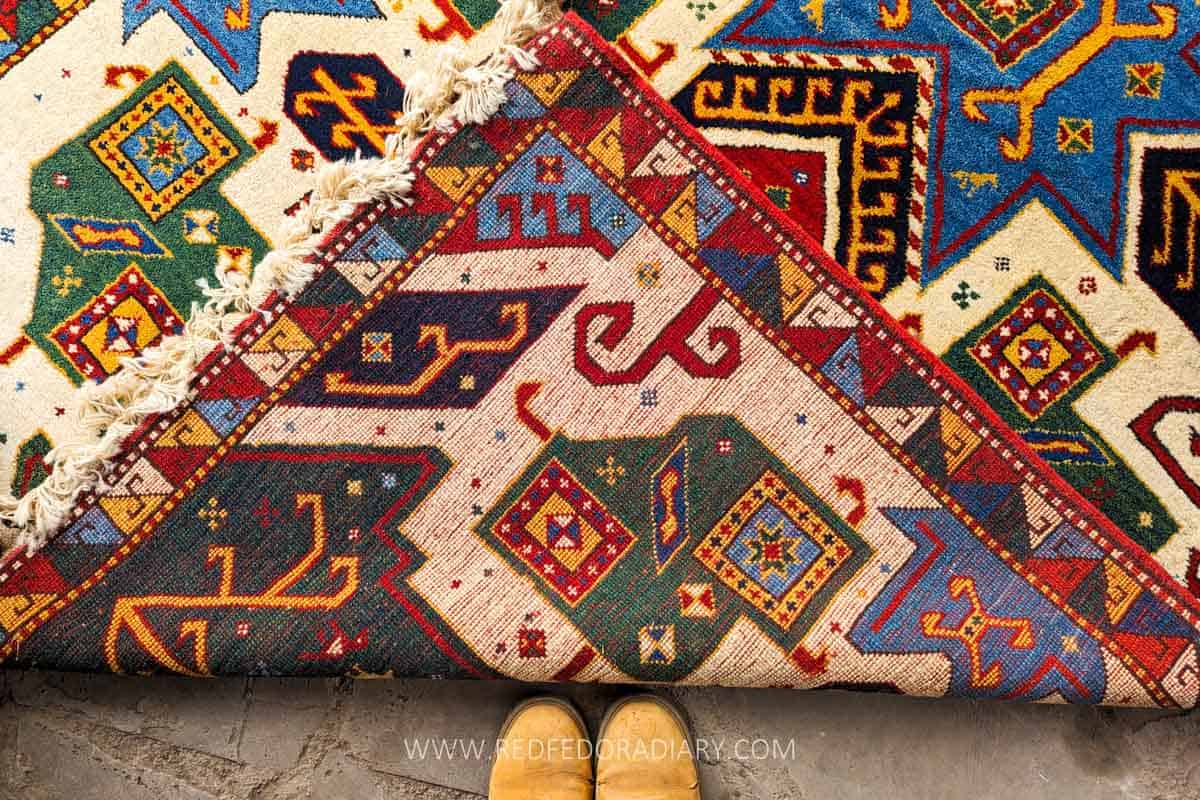
Visiting these villages offers a unique opportunity to learn more about the community that even Georgians know little about. I’m guilty as charged; I was unaware of the incredible history and culture Marneuli Municipality has carried for centuries.
While I left the place in awe, I still needed to understand the significance of Borchalo carpets in Georgia. The names and terms used during the tour were absolutely foreign to me. Everything came into the picture when I started researching for this post and ended up down the rabbit hole of carpet production in Georgia, Azerbaijan, and Armenia.
My visit to one of the two villages that still hand-weave Borchalo carpets in Georgia was part of the tour, but in the spirit of transparency, I emphasize that the following review reflects my genuine and unbiased opinions and recommendations. Rest assured, every word shared accurately represents my personal experience.
Thanks to WT Georgia and reWoven, I know more about the carpets and their symbolism, which I generally took for granted.
Book the next tour here and use code Red Fedora to get 10% OFF.
Georgia Travel Essentials
Get an eVisa: Check if you need one at iVisa and fill out the form to get your eVisa easily.
Book a flight: I use Skyscanner or WayAway. The latter has cashback with a Plus membership. More here.
Airport transfers: Avoid the hassles of public transport; book a private transfer with Welcome Pickups.
Reserve a hotel: I use Booking.com to book my hotels or apartments.
Wine tours: Book premium wine tours with Eat This! Tours. Get 5% OFF with code: RFD5.
Hiking & culture tours: WT Georgia is my favorite company for hiking and culture tours nationwide. Use code Red Fedora to get 10% OFF.
Find best-suited tours: book your other activities on Viator or Get Your Guide.
Rent a car: With affordable prices, Local Rent is one of the best car rental platforms.
Hire a driver: GoTrip is my go-to service for long-distance private transfers at very reasonable prices.
Debit card: Wise for withdrawing money in local currency without hidden fees or high exchange rates.
eSIM: I use Airalo eSIM whenever I travel. Get 3 USD with code: BAIA2592.
Travel insurance: I use SafetyWing as my insurance company, with add-ons for adventure sports and electronics theft coverage.
Disclaimer: Some of the links in this post are affiliate links, which means I may earn a small commission if you buy something through them—at no extra cost to you. It helps support my blog and lets me share real, first-hand travel tips. Learn more
The significance of carpets in Georgia
Carpets and rugs have been part of humankind since ancient times when we made them from raw animal skins to serve as heaters for the dwelling. Therefore, Georgia isn’t an exception when crafting carpets for various purposes.
Historically, a house in Georgia without a rug or carpet was a rarity. These woven masterpieces weren’t just interior decor; they were symbols of status and hierarchy, and a particularly beautiful and unique rug was a mark of nobility and luxury.
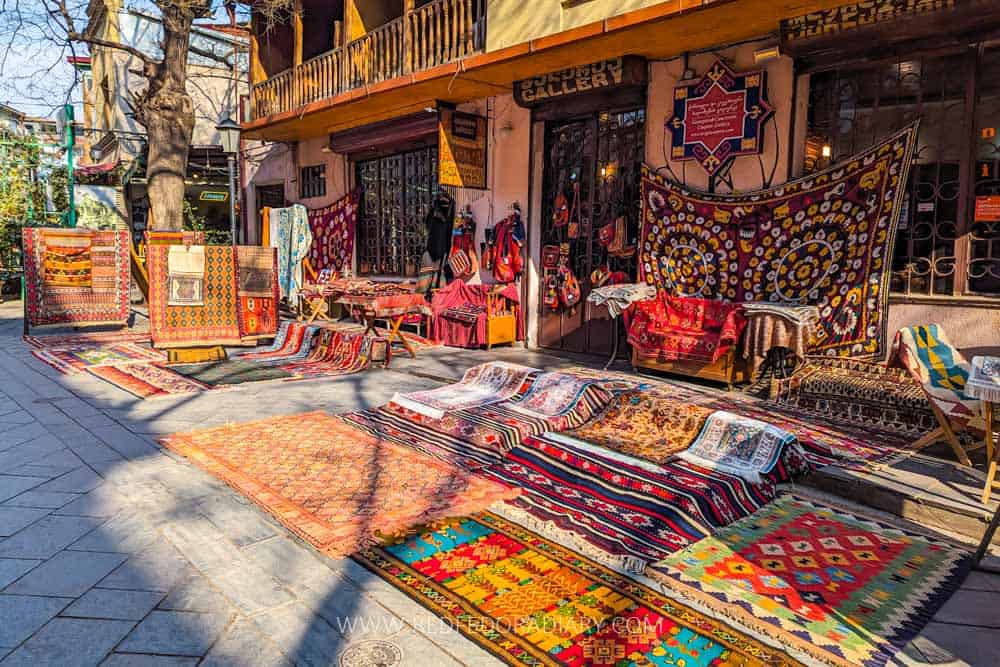
Since ancient times, Georgian families have been handing down needlework as a traditional custom – the knowledge of knitting, weaving, and embroidery was considered necessary for every woman in the family. Therefore, interior design decorations, including carpets and rugs, were popular in addition to woven embroidered clothes.
During my research, I’ve encountered the opinion that Georgian carpets do not have a characteristic, unique design and that Persian rugs heavily influence them.
On the contrary, rug weaving has always been famous in the mountainous region of Georgia, particularly Tusheti and Khevsureti. Thanks to their thick texture, rugs warmed the houses and were an ideal interior design element for the cold mountain air.
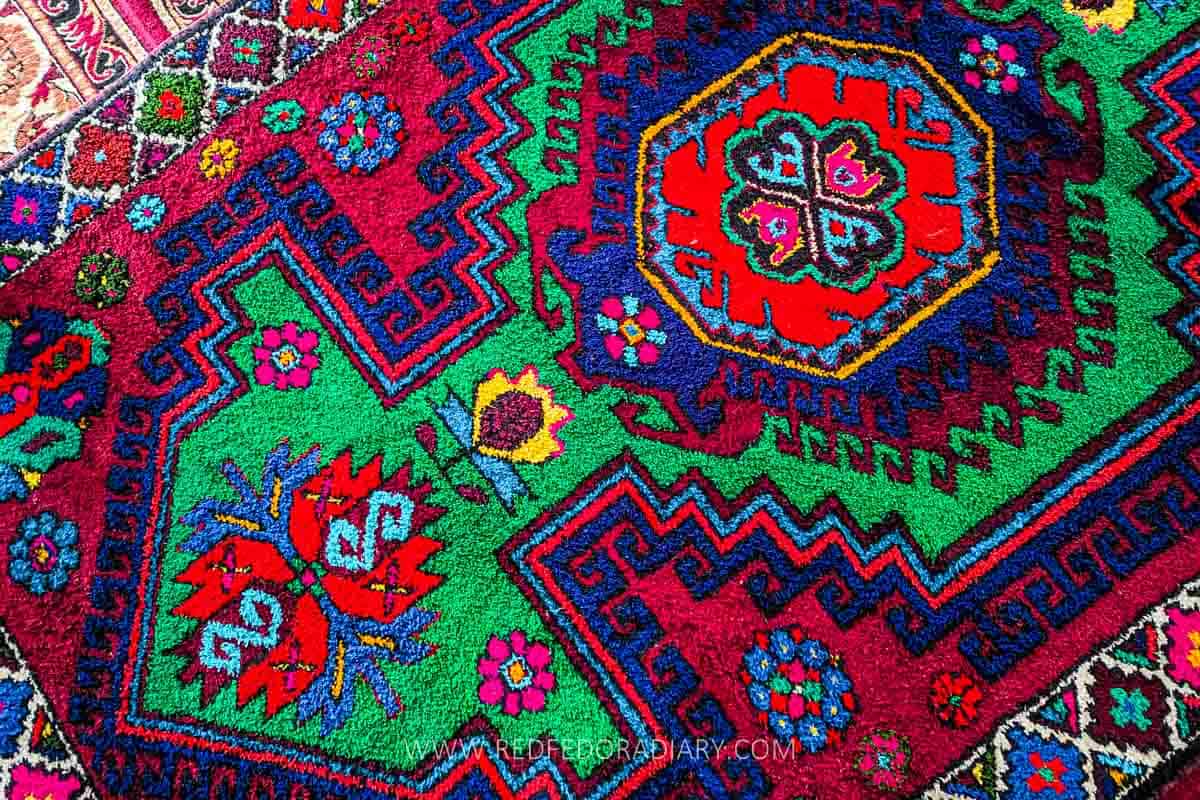
Since Georgia was part of many trade routes, it was also the hub of the carpet trade. Carpets woven here and in the east reached Europe through Tbilisi, which had a very famous carpet market in the past.
After the country’s industrialization, carpets were woven in factories, and along with the change and development of design trends, carpets have slowly lost their relevance and popularity. However, there are still a handful of weavers in Georgia that still keep the tradition going.
Wool-making process for carpets
Carpet production is directly related to the development of sheep farming. High-quality carpet requires a good selection of wool, which was shorn in spring because sheep’s fur was fluffier at this time. Women used lamb’s wool to weave the most valuable, finest carpet.
Besides the quality of the raw material, properly washing the wool was also essential. After drying, the wool was carded, and the longer it was carded, the more expensive the carpet made from it was. Then, it was hand-spun before dyeing yarns with natural dyes and weaving on a special wooden loom.
Usage of carpets in Georgia
Carpets served many other functions besides furnishing and containing heat in the household. In the Middle Ages, carpets adorned the king’s inauguration and consecration and even had a special place in the court, kept in a treasury.
Carpet weaving also became a family tradition. The bride or the bride’s mother would weave rugs or carpets for dowry. They were also woven for their own consumption and sale. During hardships, families would also pay for goods with them. And since they were considered non-necessary items, they turned into luxury objects.
Even in my childhood, I remember many of my relatives and acquaintances’ homes using rugs and carpets as their interior decoration. Not particularly beautiful and rich in colors, most likely mass-produced ones woven in dull, black, and brown palettes, I was never fond of them until I grew up and discovered a whole new world of carpets.
However, as a kid, I loved the summer ritual of carpet washing in Tbilisi courtyards. Not only was it a fun activity for kids to splash, but it was lovely to see them hanging up for drying under the sun—something I really miss witnessing in the streets of modern-day Tbilisi.
Borchalo carpets in Georgia
Borchaly, in Azerbaijani Borçalı, is a sub-category within the Gazakh group of Azerbaijani carpets.
This carpet is associated with the large tribe of Bozchalu, who lived in Naqadeh in Iranian Azerbaijan. But, according to the instructions of the Safavid rulers, the tribe was displaced approximately 75 km north of Gazakh, Azerbaijan, and settled in Georgia’s current territory of Marneuli, formerly Borchalo. Even today, the ethnic Azerbaijanis mainly inhabit the Marneuli municipality.
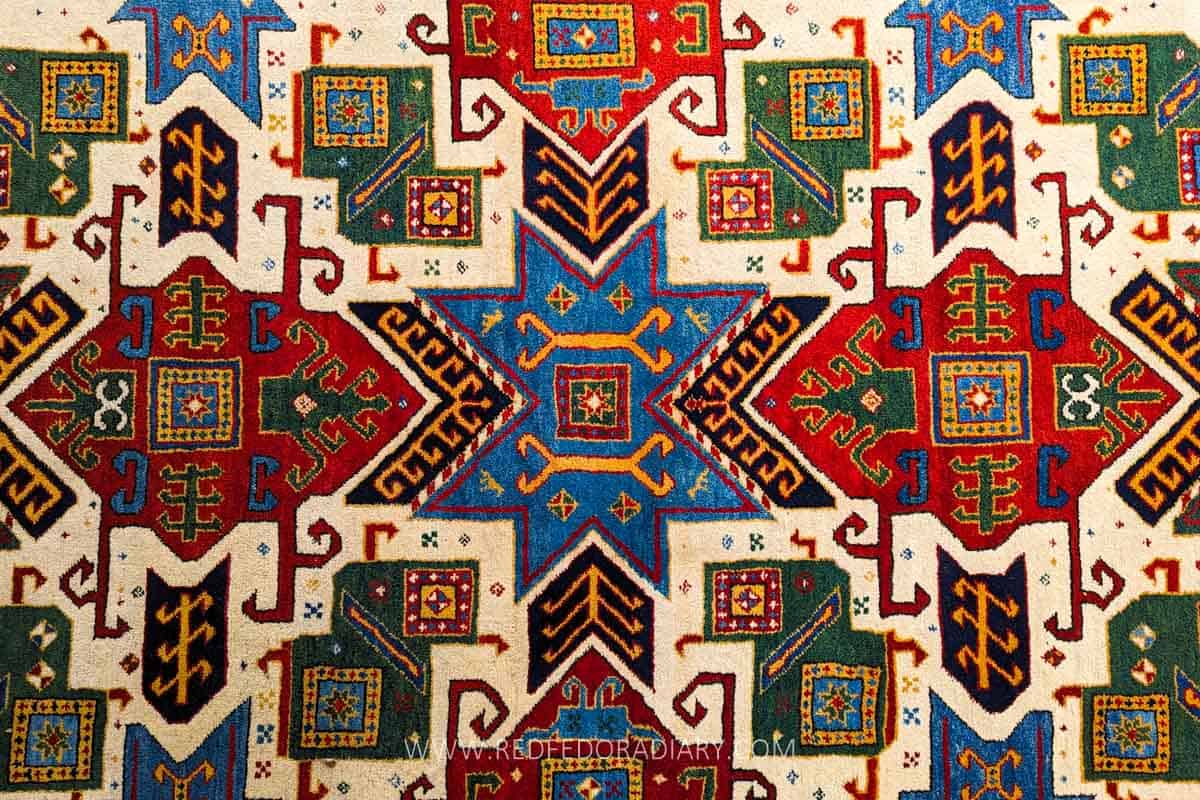
Large villages in this region, including Gurdlar, Akhurly, Kachagan, Sadakhly (Sashikhly), Dashtepe, and Lembeli, were once famous for carpet weaving. They were deeply connected to the carpet-waving centers of Popagly, located three kilometers from Gazakh, and the carpet-weaving zones Garayazy and Garachep, in the north of Gazakh.
Nearly every Azerbaijani woman has woven stunning rugs in Georgia for centuries and passed down the tradition from generation to generation. Mothers spent numerous hours weaving with their daughters beside them, imparting the skills they had learned from their own mothers.
Similar to other parts of Georgia, carpets in Azeri communities were woven to warm their homes, as gifts, and as part of the dowries, reflecting the daily life and culture of the community at that time.
These antique rugs, known by the names Bordjalou (Borçalı), Lambalo (Ləmbəli), Karachopt (Qaraçöp), and Fachralo (Faxralı), are frequently spotlighted at the world’s exclusive auction houses and sold for several thousand USD. They also are proudly exhibited in museums and personal collections around the globe.
The current state of Borchalo carpets
Unfortunately, in recent decades, the art of carpet weaving has almost entirely died out. Modernization has pushed the ancient craft of rug weaving to the brink of extinction. The arrival of inexpensive, machine-made carpets offered women an easy way to cover their floors and walls, weakening the traditional rug-weaving practice.
As the craft lost its value, women’s interest waned, and they began to focus on other activities. With fewer weavers, the quality of rugs deteriorated. Intricate, vibrant designs gave way to simpler, repetitive patterns, and stark synthetic colors replaced the harmonious natural dyes. Convenience overshadowed beauty, and the rich, creative designs of the past faded away.
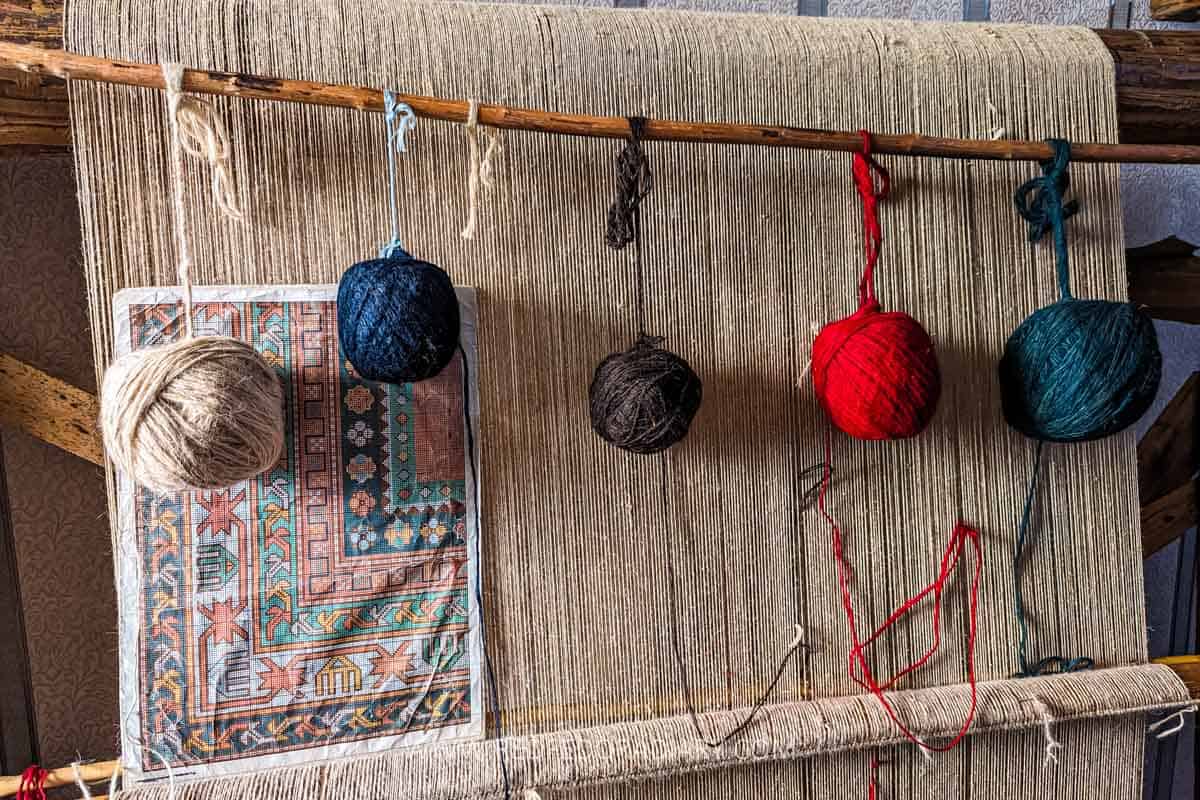
The current state of weaving in this region is threatening. Of over 129 Azerbaijani villages in Georgia and approximately 500,000 inhabitants, only two villages and less than 15 women craft Borchalo carpets. Kosalari and Iormughanlo (also known as Karachop) are the only places to find gorgeous Borchalo carpets in Georgia.
The knowledge of dyeing wool with natural methods has also been lost. With the average age of weavers being 50 and above, weaving in this once vibrant rug-producing area may cease if the current generation fails to pass on this tradition.
Thankfully, a non-profit organization, reWoven, founded in 2007 by Ryan Smith, keeps the tradition alive. Read the fascinating story of how Ryan started it all.
Works of reWoven to revive Borchalo carpets in Georgia
The dedicated team at reWoven strives to continue Ryan’s legacy of supporting the Azerbaijani community in Kosalari and Iarmughalo by employing weavers to craft exquisite rugs, restoring tradition and inspiring a younger generation to continue the practice.
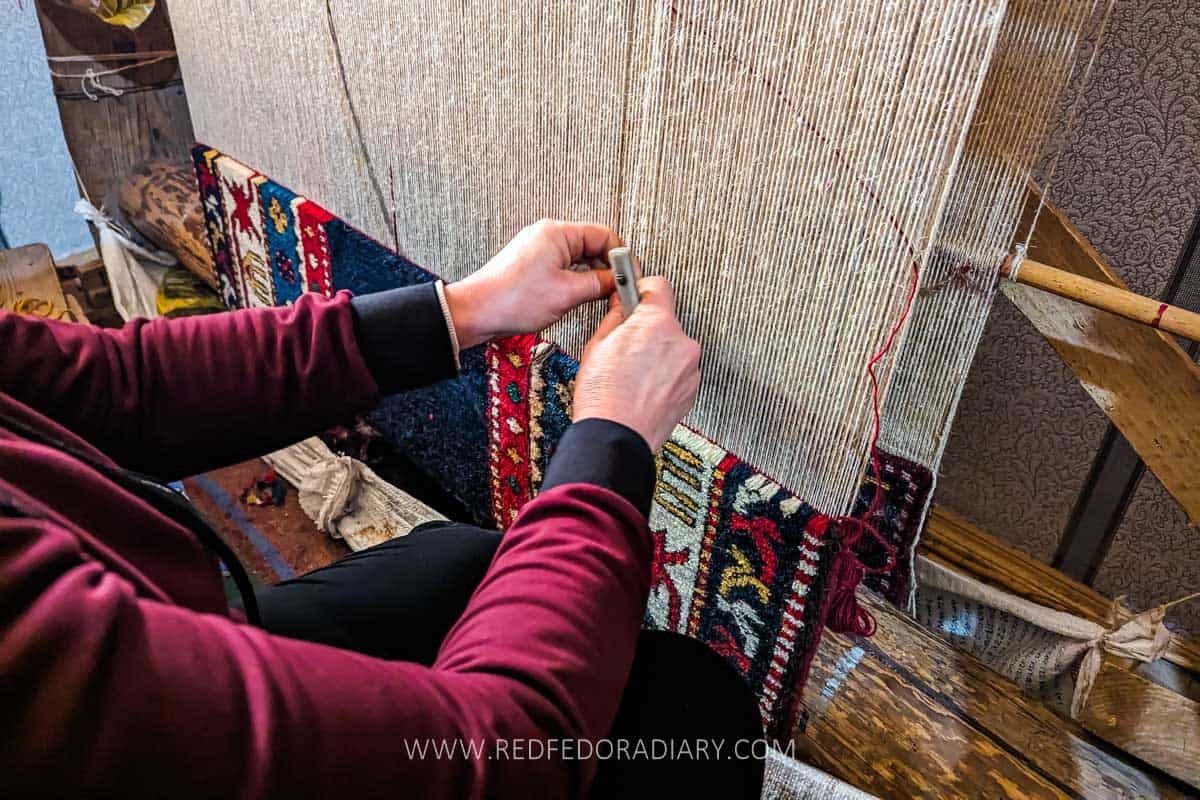
reWoven’s carpets and rugs represent centuries-old aesthetics and methods, including using naturally dyed hand-spun wool yarns, historical designs, and hand weaving. Weavers still hand spin their own undyed white and black wool into yarn, while the organization imports naturally dyed colored yarn from neighboring countries, including Azerbaijan.
As a non-profit, all the earnings from the project remain within the village, maximizing the benefits to the weavers. By doing so, there is a hope that more women will be interested in being involved in the project as they’ll see more financial and economic benefits to the community.
In addition to their high-quality materials and cultural authenticity, reWoven rugs are valued for their personal connection between the customer, the weaver, and their community. Each rug has a certificate ensuring its quality and origin, personal information about the weaver, and images of the process on the loom. The price of 1 square meter of a Borchalo carpet at reWoven is 400 USD.
Rugs and carpets are sold online and then shipped to customers worldwide. As Kosima, the Creative Director of reWoven, told me, she has more demand than she can meet with only a handful of weavers.
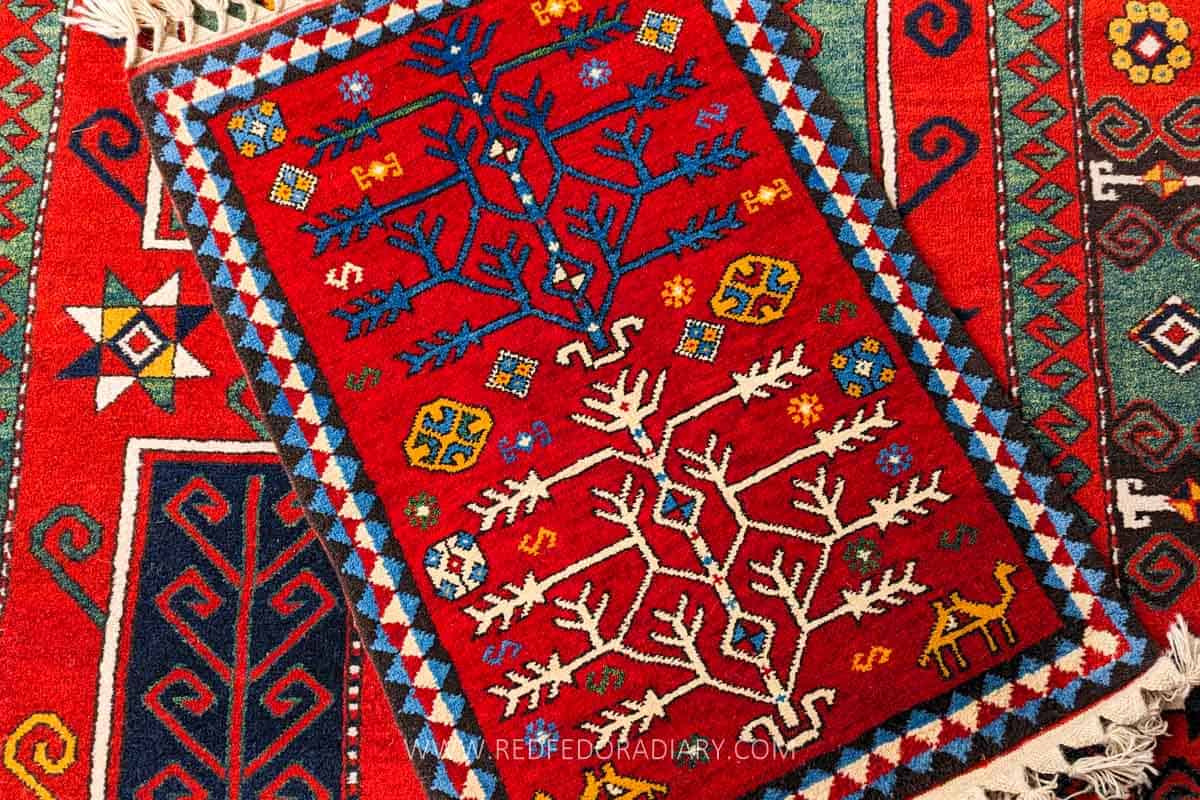
They currently work with 12 women, but only five can weave anytime. Depending on the size, design, and the weaver’s availability, it takes anywhere between one and four months to complete the rug.
That said, reWoven gives its weavers flexibility by letting them decide how fast or slow they want to weave, and as Kosima explains, thankfully, the customers are very understanding.
In the future, Kosima also hopes to revive natural, local dyeing techniques for its yarns instead of importing them from Baku.
A few years back, they would also send their rugs to Azerbaijan for washing, drying, and fishing touches. However, due to the land border closure for the last three and a half years, they had to be resourceful and figure out ways to finish their products locally.
Today, they wash the rugs themselves, burn the backs to ensure there’s no fluff left on them, and shave them to create beautiful piles from top to bottom in Kosalari.
What makes Borchalo carpets unique
Generally speaking, Borchalo carpets in Georgia differ from those in the Caucasus and East, particularly from Persian Borchalo, in terms of weaving technique and design.
Kosalari and Karachop (Iermughalo) rugs are woven on old wooden, upright looms. Some of them are over 100 years old and were provided by the Imperial Russian government to encourage craftsmanship in the region.
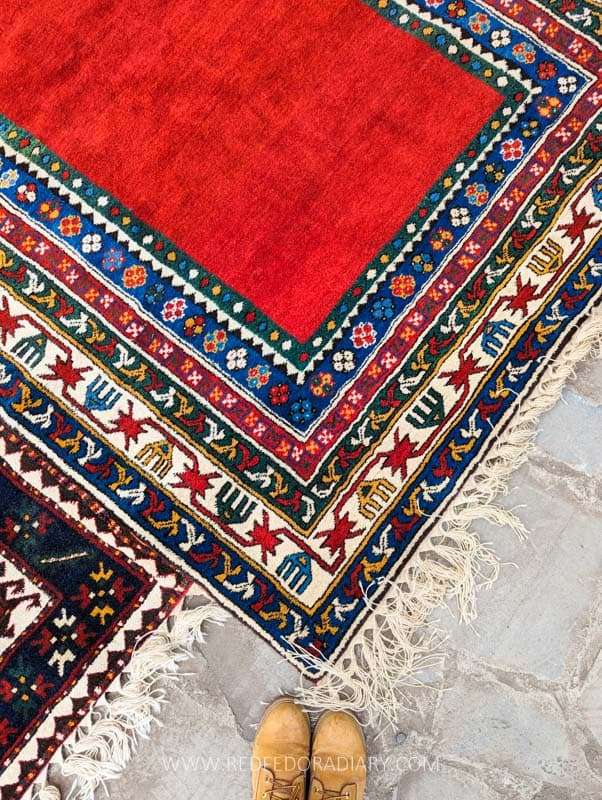
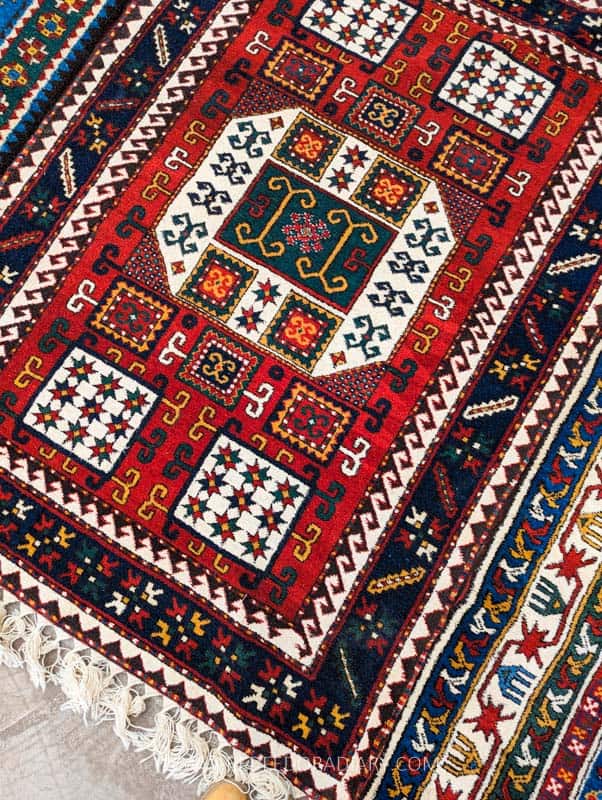
Depending on the creative structure, Borchalo carpets have several designs and types. Carpets and rugs from Karachop and Borchalo are known for their long pile and looser weave, resulting in a woolly silkiness.
Even though the majority of Marneuli Municipality’s population is Muslim, Borchalo carpets rarely have religious symbols unless they are made for a mosque.
Their bold, ornamental, geometric, almost tribal rug design generally reflects mythological symbols, beliefs, and totems. These motifs once had a mystical and religious meaning and have been passed down over the centuries. However, they have lost their religious symbolism and were turned into decorative details.
Their rich colors, particularly the bright red used in Georgia, also set Borchalo carpets apart, indicating their origin. The red dye comes from the madder root, which we also use to dye our eggs for Easter. Mignonette flowers give yellow dye, blues are from indigo, and green is a combination of blue and yellow. Unlike the chemical ones, which have a maximum life span of 50 years, natural dyes last longer, centuries, and the colors don’t fade away.
The technique used for Borchalo carpets is also different. The tick wool used enables the weaver to have fewer knots in one square inch. Because of the fewer knots, the patterns must be bolder and more graphic. Moreover, these rugs and carpets are chunky, soft, and lightweight.
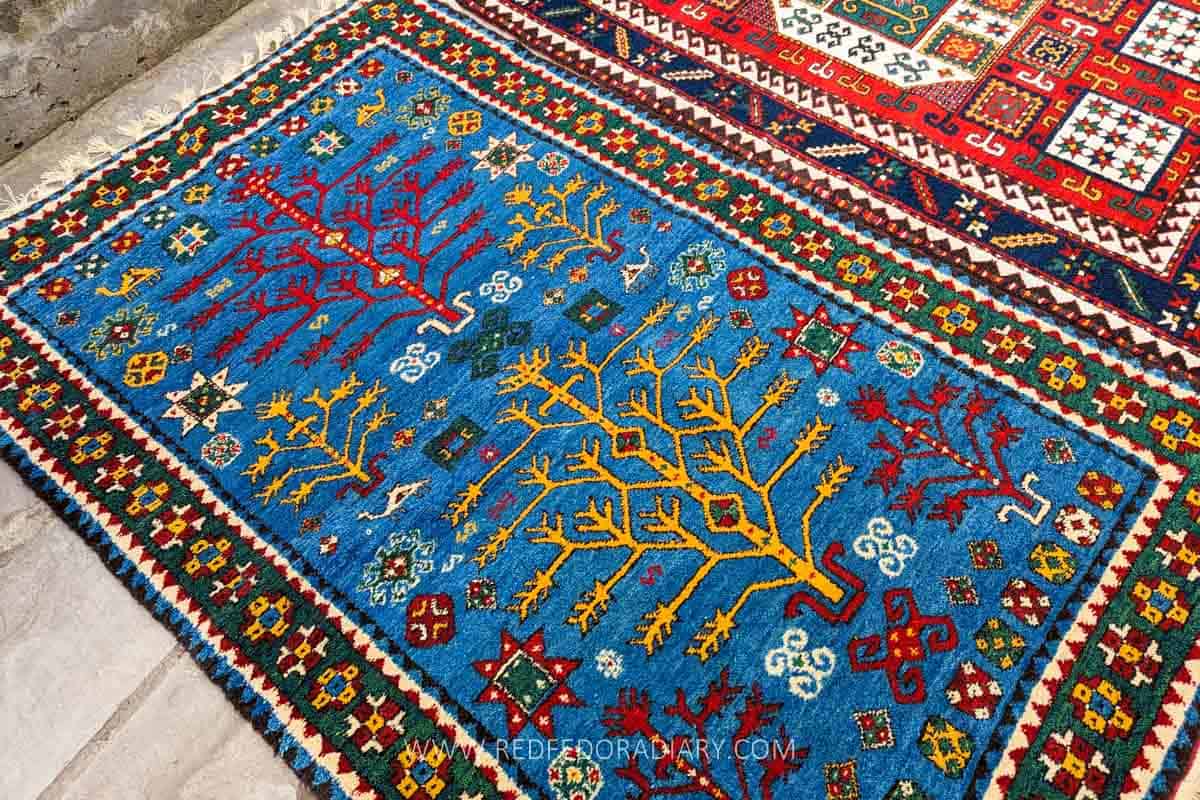
Design, elements, and the villages where they are woven also distinguish handwoven Borchalo carpets. However, similar ornaments are present in all, including gols (in Farsi, it means flower and is often used to describe a floral medallion or rosette), trees, birds, camels, dogs, etc.
The most common design of Borchalo carpets is the Tree of Life, which is often gifted as a wedding present or woven as part of the dowry. In local mythology, the carpet symbolizes a family’s wealth, whereas the tree is usually intended to be Cottonwood, a symbol of strength.
The tree branches signify fertility and represent future generations. There’s also a camel for wealth and a stylized eye to protect the family from the evil eye.
The artistic expression of the weaver determines whether other symbols are included. For instance, birds symbolize good news, a dog is a family friend, and a star represents light and purity.
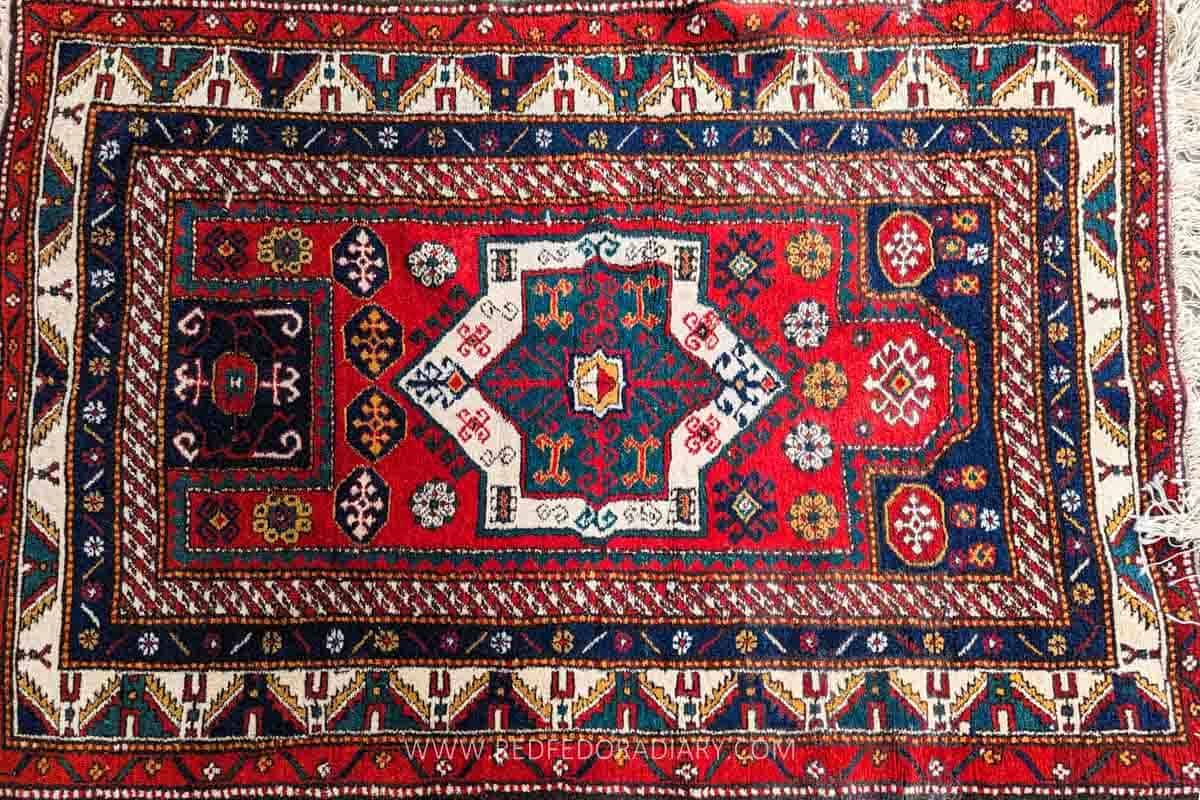
The incorporation of these motifs mirrors the weavers’ life experiences, traditions, and even historical events. Their complex masterpieces interweave the essence of their culture, lifestyle, and past affairs, creating carpets rich not only in colors and patterns but also in storytelling.
Besides the Tree of Life, reWoven also creates other designs, such as Lori Pambak, characterized by an octagonal medallion and a rich red, ivory, and uncommon green palette.
Chalaberd Kazak rugs, also called Caucasian Eagle Kazak rugs, feature sunburst medallions, dragons, and temple arches. Pinwheel Kazak is another design named after a form that resembles a rotating pinwheel with curling hooks.
They have a few other designs(Karachop, Memling Gul, Lezghi Star, Sevan Kazak, Star Kazak, Lambalo, Moghan, etc.) and are flexible enough to custom-make them for you.
How to visit Kosalari and weavers
Kosalari is about an hour’s drive from Tbilisi. The easiest way to visit the weavers, get hands-on experience, and learn more from those directly involved in the project is to join a tour of my friends and partners at WT Georgia.
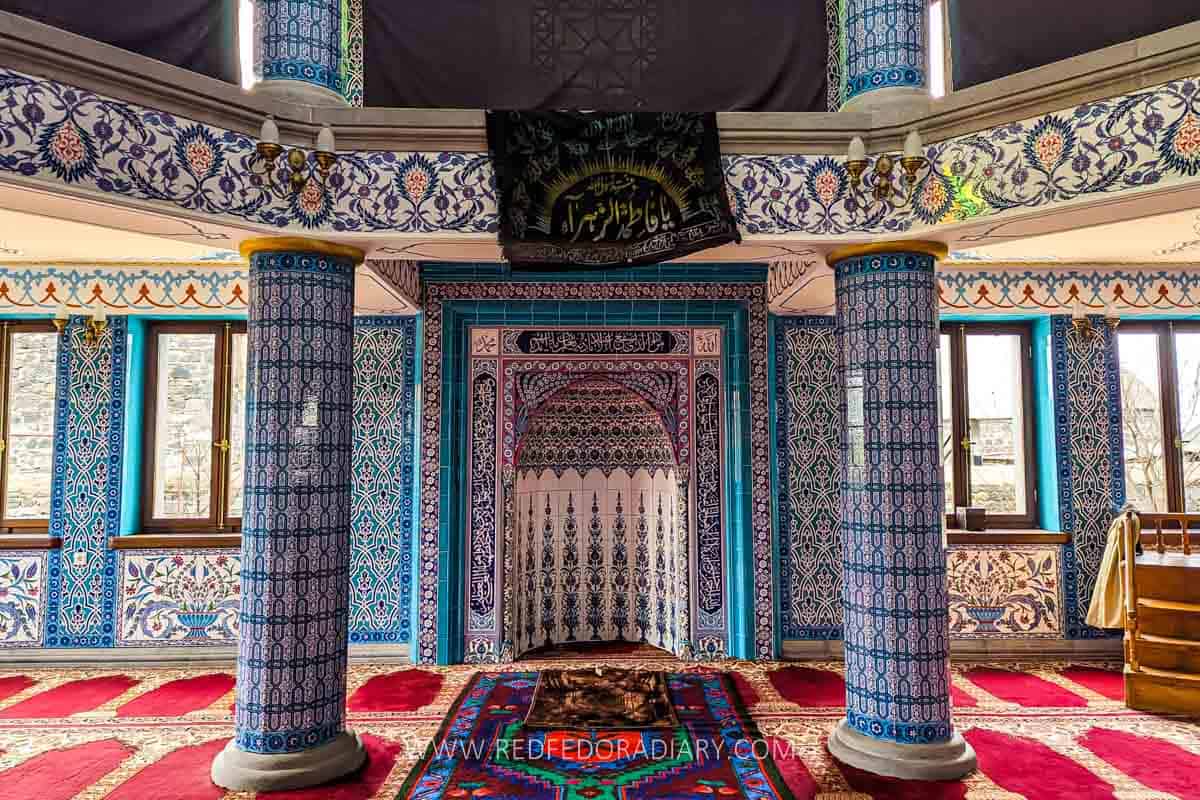
This half-day tour is one of the most unusual day trips from Tbilisi and includes a visit to the beautiful Kosalari mosque, where Kosima will briefly make you pay attention to the carpets made from artificial coloring before driving to one of the houses in the village.
You’ll see already laid-out carpets on the courtyard pavement or hanging from the balcony railing. This is where Kosima and her colleague Zaur explain everything about Borchalo carpets, the tradition, techniques, and symbolism. They are very friendly and eager to answer any questions you may have.
After the introduction, you’ll walk to a neighboring house to see the process and try it yourself. On our tour, we went to Elmira Ceferova’s house to see the process she’s been working on for two weeks.
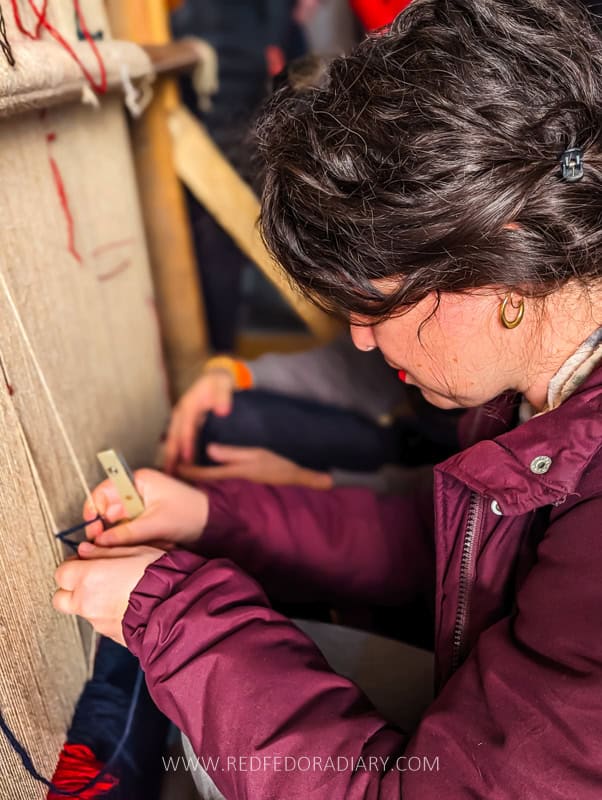
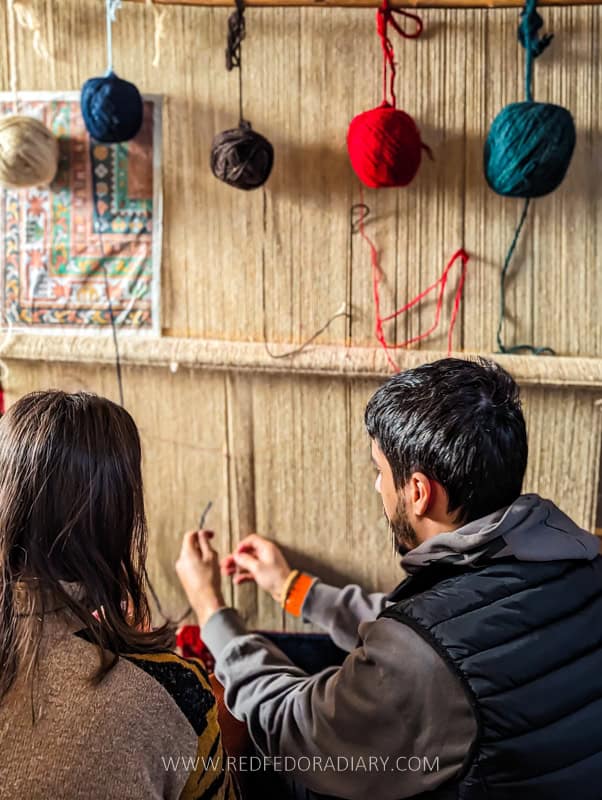
There, Kosima explained the loom’s structure and technique while Elmira’s hands moved very quickly to demonstrate the actual method. Then, we were given some time to partake and weave a few knots. It looked much harder than it actually is once you get the hang of it.
Once everyone was done weaving, we returned to the first house and were treated to a delicious Azeri meal. Khingal is a handmade thin noodle dish where pasta is cut into rectangular shapes. Once boiled, it is topped with melted butter and caramelized onions. The non-vegetarian version includes ground beef.
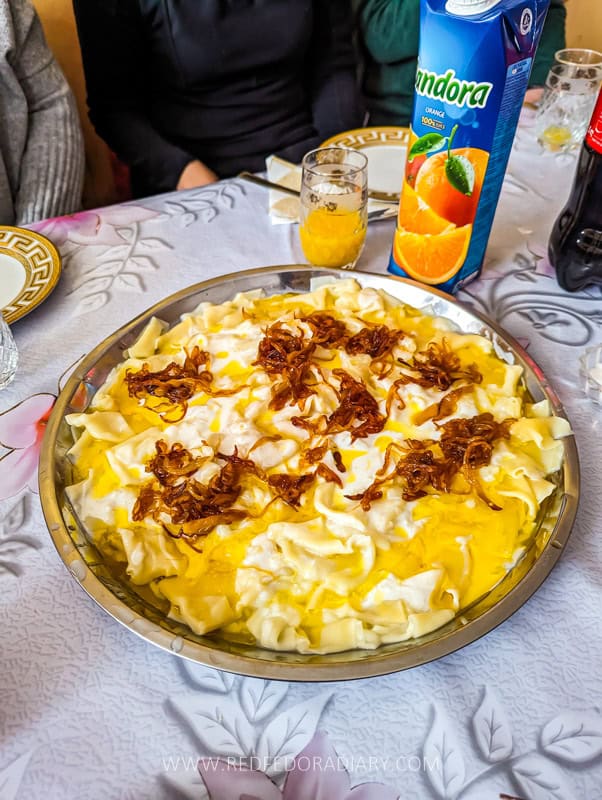
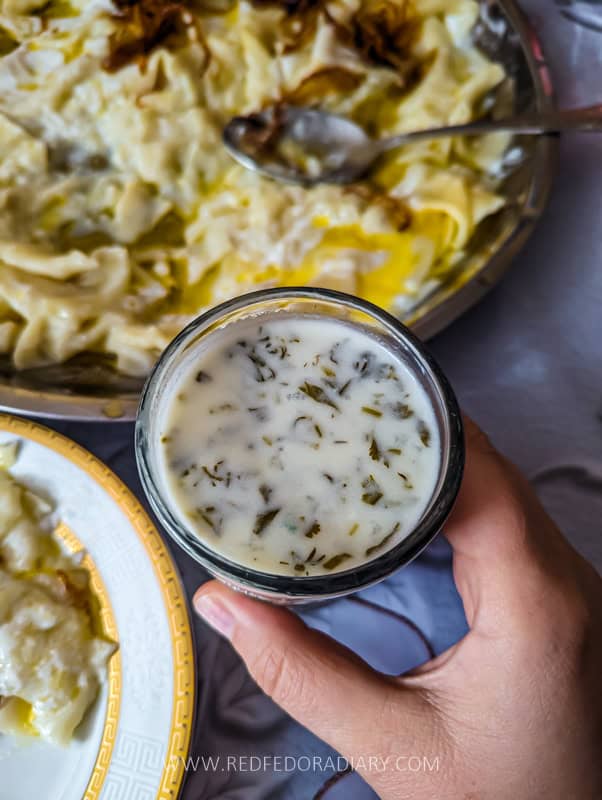
The hosts also served us Dovgha – a yogurt with herbs, eggs, and chickpeas. It’s typically warm in winter (the type we’ve tried), while in summer, it is cold.
The lunch included Azeri tea in tulip-shaped cups, fruits, candies, and a homemade cake.
WT Georgia will host the next tour to Kosalari on June 29th, so make sure you book on time, as the group is typically very small. The other dates for group tours are not yet available, but WT Georgia is happy to organize a private tour for you. When booking, make sure you use the code Red Fedora to get 10% OFF.
